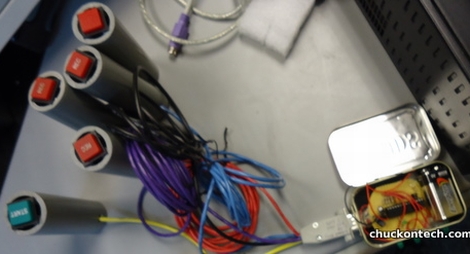The sales team in [Chuck’s] office is a pretty competitive bunch as you might expect, and they decided that they wanted a system which would allow them to challenge one another during their weekly meetings. The competition involves answering questions posed by their manager, but hand raising only works for so long – they needed a definitive way to tell who “buzzed in” to answer a question first.
Since [Chuck] only had a short bit of time and a tiny budget to work on, he opted to find the easiest solution to the problem, which was an Arduino-based game show buzzer system. The game display is built from an Arduino, some LEDs and an Altoids tin, while the buzzer pushbuttons were salvaged from an old radio broadcast console.
Now, when a question is posed, the salesman can buzz in to answer, knowing that only the quickest person’s button click will be registered. When it’s time for another question, the host simply clicks his buzzer to reset the console.
While it’s not quite as fancy as this game buzzer system we featured a while back, [Chuck] says it does the job perfectly and was cheap to boot.
Continue reading to see a short video of the office game buzzer system in action.
[youtube=http://www.youtube.com/watch?v=8UfxOmglSBg&w=470]
















Your Arduino gets bored to death with such a simple task.
A 74HC573 latch would have done the same, doesn’t need programming and just costs a few cents.
good build
and as time was a factor, using soemthing already lying around (AVR) was good based on the time available to produce a buzzer system in such a fast paced enviroment! and the buttons look durable.
if anyones wondering, yes it can easily be done with logic chips but it would take hours of building as opposed to this one probably took 45 mins. if hes building a buzzer, then there MUST be a test to study for!!! lol
PPPS:first, the 1st input of andgates comes from buttons.
THEN
resetbtn.>diodes>capacitors>2ndinput/andgates,(output/)andgates>flipflops>dischargesofcapacitors(BJTs+lots diodes)>LEDs(contestants)>diodess>buzzer(main)
Scrounging for surplus or used components you can build the US Department Of Energy National Science Bowl buzzer system for very cheap.
http://science.energy.gov/nsb/high-school/high-school-regionals/hs-rules-forms-resources/make-your-own-competition-buzzer/
I you have a laptop you could also use Buzz! buzzers. They are standard USB HID so in 45 min you can have software that also shows the time, and logs all the data.
SCRs.
I built a nice buzzer system a few years ago, with a *huge* 7 segment display and pvc tube as handles with a push button on top, all controlled by a microchip pic. You can check the pictures of the end result at http://aeminium.org/slug/hardware/buttongame/pics/
and code and other information at https://aeminium.org/slug/hardware/buttongame/
A bunch of flip-flops would have been sufficient. Punting in a microcontroller seems a bit of a waste.
The code seems to be wrong. When checking one by one, how is that fair? Shouldn’t you just check all at once? Even if the difference is just 1/100th of a second.
Alternetive polling code:
/* check all triggers at once by checking the whole port, in PIC that would be PORTA, PORTB etc. In AVR I’m not sure so i called it input_port.
*/
While (input_port = 0xFF) {};
saved_input = input_port;
switch (saved_input) {
case 0b1111110: LED1 = 1; break;
case 0b1111101: LED2 = 1; break;
case 0b1111011: LED3 = 1; break;
case 0b1110111: LED4 = 1; break;
default: ERROR = 1; break;
}
Can anyone think of how this could be made arduinoless?
The two ways I can think of SR latches with negative feedback from the Q to R’s wont work without messy diodes everywhere, nor will 555s.
I’ve always wanted a simple system like this though.
I should point out I realise others have mentioned latches etc but I don’t buy they would be that neat.
I already posted “SCRs!”
http://www.techlib.com/electronics/games.html
Use LEDs with series resistors in place of lamps.
“Neat” how? Tidy? Depends on your soldering. I can see that “minty box” getting jerked around pretty good at end-of-quarter sales meetings.
There are a lot of ways (as mentioned here) to do this without an Arduino. Most of those ways are better, IMHO.
Most of them would have required more solder time and scrounging for parts on my part. This took me 2 hours to build on a Sunday while watching X-Files.
It’s far from perfect and if this system was being used by customers and not internal sales people I would be more worried about the “tie factor”.
I’ve seen the National Science Bowl electro-mechanical system built into a small, cheap, plastic toolbox with the player buttons built from heavy duty surplus button switches (made really beefy contacts for switching high voltage) mounted in commercial grade plastic electrical boxes for plug-ins or switches. The five boxes were connected using modular jacks and phone cord. The bell used was an old dorbell and the four lights were mounted to the toolbox lid, as was the reset button.
How it works is simple. The first button pressed causes its relay to close and hold, while disconnecting the other relays. The reset button disconnects all the power to the relays so they go back to their normal position.
SCRs and other electronic parts can take the place of the relays, but that’s added complexity.
Weekly meetings with a contest. Could they come up with any more ways to waste peoples time. Alex, I’ll take Job Search for $1000.
Early Morning Weekly meetings where nothing is ever brought up that has any bearing at all on my job, so why must I go to these damn meetings?
I did six months of that doing helldesk support for an ISP.
Even if you read states simultaneous from registers, I’d still worry about contact bounce. Is contact bounce a problem?